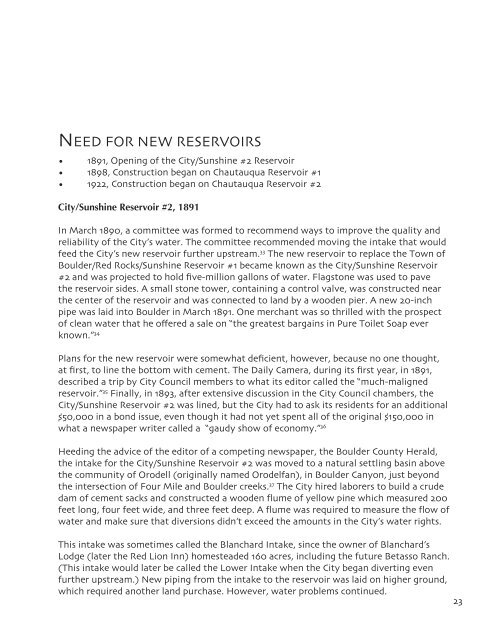You also want an ePaper? Increase the reach of your titles
YUMPU automatically turns print PDFs into web optimized ePapers that Google loves.
NEED FOR NEW RESERVOIRS<br />
• 1891, Opening of the City/Sunshine #2 Reservoir<br />
• 1898, Construction began on Chautauqua Reservoir #1<br />
• 1922, Construction began on Chautauqua Reservoir #2<br />
City/Sunshine Reservoir #2, 1891<br />
In March 1890, a committee was formed to recommend ways to improve the quality and<br />
reliability of the City’s water. The committee recommended moving the intake that would<br />
feed the City’s new reservoir further upstream. 33 The new reservoir to replace the Town of<br />
Boulder/Red Rocks/Sunshine Reservoir #1 became known as the City/Sunshine Reservoir<br />
#2 and was projected to hold five-million gallons of water. Flagstone was used to pave<br />
the reservoir sides. A small stone tower, containing a control valve, was constructed near<br />
the center of the reservoir and was connected to land by a wooden pier. A new 20-inch<br />
pipe was laid into Boulder in March 1891. One merchant was so thrilled with the prospect<br />
of clean water that he offered a sale on “the greatest bargains in Pure Toilet Soap ever<br />
known.” 34<br />
Plans for the new reservoir were somewhat deficient, however, because no one thought,<br />
at first, to line the bottom with cement. The Daily Camera, during its first year, in 1891,<br />
described a trip by City Council members to what its editor called the “much-maligned<br />
reservoir.” 35 Finally, in 1893, after extensive discussion in the City Council chambers, the<br />
City/Sunshine Reservoir #2 was lined, but the City had to ask its residents for an additional<br />
$50,000 in a bond issue, even though it had not yet spent all of the original $150,000 in<br />
what a newspaper writer called a “gaudy show of economy.” 36<br />
Heeding the advice of the editor of a competing newspaper, the Boulder County Herald,<br />
the intake for the City/Sunshine Reservoir #2 was moved to a natural settling basin above<br />
the community of Orodell (originally named Orodelfan), in Boulder Canyon, just beyond<br />
the intersection of Four Mile and Boulder creeks. 37 The City hired laborers to build a crude<br />
dam of cement sacks and constructed a wooden flume of yellow pine which measured 200<br />
feet long, four feet wide, and three feet deep. A flume was required to measure the flow of<br />
water and make sure that diversions didn’t exceed the amounts in the City’s water rights.<br />
This intake was sometimes called the Blanchard Intake, since the owner of Blanchard’s<br />
Lodge (later the Red Lion Inn) homesteaded 160 acres, including the future Betasso Ranch.<br />
(This intake would later be called the Lower Intake when the City began diverting even<br />
further upstream.) New piping from the intake to the reservoir was laid on higher ground,<br />
which required another land purchase. However, water problems continued.<br />
23



